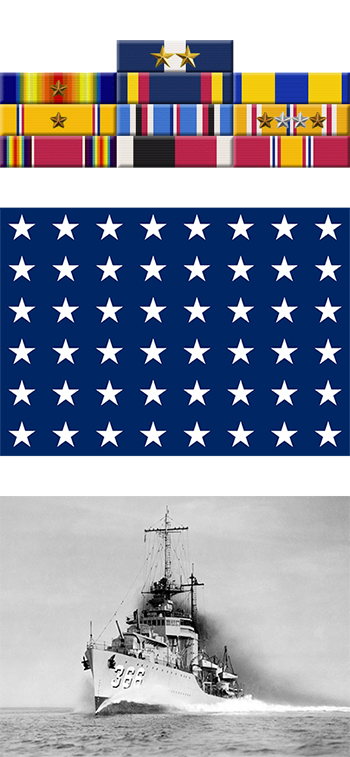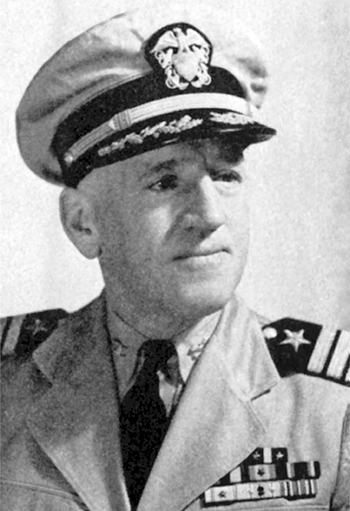
|
Laurence A. Abercrombie |
 |
|||
| Rank, Service | ||||
Rear Admiral O-8, U.S. Navy |
||||
| Veteran of: | ||||
|
||||
| Tribute: | ||||
Laurence Abercrombie was born on October 11, 1897, in Lawrence, Massachusetts. He attended Phillips Academy in Andover, Massachusetts, before entering the U.S. Naval Academy in June 1917. During World War II, Midshipman Abercrombie served aboard the battleships USS Delaware (BB-28), USS Georgia (BB-15), USS Nevada (BB-36), and USS Mississippi (BB-41), during the summers of 1917 and 1918. As a member of the top half of the graduating Class of 1921 (1921-A), he was graduated a year early due to World War I, and was commissioned an Ensign in the U.S. Navy on June 3, 1920. LTJG Abercrombie served aboard the destroyer tender USS Black Hawk (AD-9) from June 1920 to April 1923, and then aboard the gunboat USS Villalobos (PG-42) at Shanghai, China, on Yangtze River Patrols from April to May 1923. His next assignment was aboard the patrol yacht and flagship of the Yangtze Patrol, USS Isabel (PY-10) from May 1923 to July 1924, followed by service aboard the armored cruiser USS Huron (CA-9) from July 1924 until he returned to the United States in July 1925. During this time he participated in the landing and operations in Chefoo, China, in November 1924. He served aboard the battleship USS Utah (BB-31) from July 1925 to August 1926, and then served as an Instructor in French with the Department of Modern Languages at the Naval Academy from August 1926 to May 1928. LT Abercrombie then served aboard the armored cruiser USS Pittsburgh (CA-4) from July 1928 to January 1931, and during this time he attended the coronation of Emperor Hirohito of Japan in November 1928. His next assignment was in the Bureau of Navigation in Washington, D.C., from April 1931 to August 1933, followed by service at the Navy Yard in New York City for the fitting out of the heavy cruiser USS New Orleans (CA-32) in August 1933. He became a plankowner of USS New Orleans upon her commissioning on February 15, 1934, and served aboard her until May 1937, serving as Communications Officer his last few months aboard. LCDR Abercrombie again served as a French Instructor in the Department of Modern Languages at the Naval Academy from June 1937 to June 1939, and he then served as Gunnery Officer aboard the battleship USS Arizona (BB-39) from June 1939 to March 1941. He then served as Commanding Officer of the destroyer USS Drayton (DD-366) from March 1941 to July 1942, having been promoted to Captain in June 1942. During this time he engaged and sunk an enemy vessel on December 24, 1941, for which he was awarded his first Navy Cross. His next assignment was as Commander of Destroyer Division NINE from July 1942 to August 1943, and during this time he was awarded his second and third Navy Crosses for actions near the Gilbert Islands on October 22, 1942, and near the Solomon Islands on February 17, 1943. CAPT Abercrombie served in the Office of Naval Intelligence, Office of the Chief of Naval Operations in the Navy Department from August 1943 to April 1944, and then with the Joint Chiefs of Staff from April 1944 to early 1945. After serving at the Naval Training School in San Francisco, California, he served as Commanding Officer of the cruiser USS Chester (CA-27) from August to December 1945. His next assignment was as Director of the Naval Reserve program in the Potomac River Naval Command from March to October 1946, followed by service as assistant to the Assistant Chief of Naval Operations (Naval Reserve) and the Chief of the Naval Reserve from October 1946 to May 1949. CAPT Abercrombie's final assignment was in the Office of the Secretary of Defense from May 1949 until his retirement from the Navy on July 1, 1951. Upon his retirement from the Navy, CAPT Abercrombie was promoted to Rear Admiral. Laurence Abercrombie died on May 3, 1973, and was buried at Saint Marys Catholic Cemetery in Barnesville, Maryland. |
||||
|
||||

